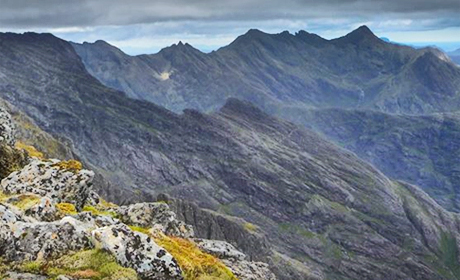The Cuillin
Isle of Skye, Inner Hebrides, Scotland

The Cuillin Hills are considered to be the most dramatic mountain range in Britain. The tall, dark, jagged peaks of the main Cuillin Ridge (the Black Cuillin) and the more rounded eastern hills of the Red Cuillin, attract climbers and walkers all year round.

The Cuillin Hills are the remains of the roots of an early Palaeogene volcanic centre. The rugged peaks of the Black Cuillin are mostly composed of gabbro, whilst the more rounded slopes of the Red Cuillin are granitic.
The igneous rocks on Skye have been studied since the 1800′s by the likes of Sir Archibald Geikie and John Wesley Judd (1879 – 1914), with both making headway into understanding the nature of the rocks. But it was Dr Alfred Harker (1859 – 1939) who studied, mapped and interpreted these igneous rocks in the early 1900′s, who first recognised the island’s true importance.
Much of the Isle of Skye is composed of basaltic lava flows, erupted during the earliest phase of volcanic activity in the area – known as the Skye Main Lava Series. These were erupted from early fissure eruptions and not from the volcanoes above the main Cuillin Centre. The emplacement of this main centre came slightly later, followed by the emplacement of two Red Hills Centres.

Formation of the Cuillins
The rocks of the Black Cuillin formed as a result of the emplacement of the main Cuillin Centre. This is a basic/ultrabasic centre with several main features:
- outer gabbros: coarse grained
- an inner and outer layered series: mostly allivalite, peridotite and eucrite
- minor intrusions: dykes, cone sheets, agglomerates and explosion breccias
As time progressed, the magmatic activity became more acidic. Following the emplacement of the Cuillin Centre, a younger, smaller acidic centre was emplaced. This, the Strath na Crèitheach centre, was intruded into the main Cuillin Centre and so is exposed in the Black Cuillin.
The emplacement of the two granitic Red Hills Centres came next; the Western Red Hills followed by the Eastern Red Hills. Although dominantly granitic bodies, they also show evidence of mixed magma (acid-basic) intrusions, felsites, ignimbrites, tuffs and agglomerates.
The intrusion of dolerite dykes occurred throughout the history of the formation of both the Black and Red Cuillins.
Text: Scottish Geology
Related Links
Nearby Geosites
Images (tip to bottom):- The Black Cuillin © Janis Russell
- Sgùrr nan Gillean from Sligachan. The river Sligachan flows over red granite, contrasting with the darker gabbro of the peaks © David Iliff (Source Wikimedia Commons) Creative Commons Attribution-Share Alike 3.0 Unported
- The main ridge of the Black Cuillin © Adrian Pingstone (Source Wikimedia Commons) Public Domain

October 13 - 21
Theme: 'Earth Science in our lives'
